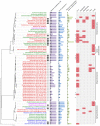Comparative Genomic Analysis of Neutrophilic Iron(II) Oxidizer Genomes for Candidate Genes in Extracellular Electron Transfer
- PMID: 28871245
- PMCID: PMC5566968
- DOI: 10.3389/fmicb.2017.01584
Comparative Genomic Analysis of Neutrophilic Iron(II) Oxidizer Genomes for Candidate Genes in Extracellular Electron Transfer
Abstract
Extracellular electron transfer (EET) is recognized as a key biochemical process in circumneutral pH Fe(II)-oxidizing bacteria (FeOB). In this study, we searched for candidate EET genes in 73 neutrophilic FeOB genomes, among which 43 genomes are complete or close-to-complete and the rest have estimated genome completeness ranging from 5 to 91%. These neutrophilic FeOB span members of the microaerophilic, anaerobic phototrophic, and anaerobic nitrate-reducing FeOB groups. We found that many microaerophilic and several anaerobic FeOB possess homologs of Cyc2, an outer membrane cytochrome c originally identified in Acidithiobacillus ferrooxidans. The "porin-cytochrome c complex" (PCC) gene clusters homologous to MtoAB/PioAB are present in eight FeOB, accounting for 19% of complete and close-to-complete genomes examined, whereas PCC genes homologous to OmbB-OmaB-OmcB in Geobacter sulfurreducens are absent. Further, we discovered gene clusters that may potentially encode two novel PCC types. First, a cluster (tentatively named "PCC3") encodes a porin, an extracellular and a periplasmic cytochrome c with remarkably large numbers of heme-binding motifs. Second, a cluster (tentatively named "PCC4") encodes a porin and three periplasmic multiheme cytochromes c. A conserved inner membrane protein (IMP) encoded in PCC3 and PCC4 gene clusters might be responsible for translocating electrons across the inner membrane. Other bacteria possessing PCC3 and PCC4 are mostly Proteobacteria isolated from environments with a potential niche for Fe(II) oxidation. In addition to cytochrome c, multicopper oxidase (MCO) genes potentially involved in Fe(II) oxidation were also identified. Notably, candidate EET genes were not found in some FeOB, especially the anaerobic ones, probably suggesting EET genes or Fe(II) oxidation mechanisms are different from the searched models. Overall, based on current EET models, the search extends our understanding of bacterial EET and provides candidate genes for future research.
Keywords: cytochrome c; extracellular electron transfer (EET); genomics; multicopper oxidase; neutrophilic Fe(II) oxidation; porin-cytochrome c complex (PCC).
Figures








Similar articles
-
Iron Oxidation by a Fused Cytochrome-Porin Common to Diverse Iron-Oxidizing Bacteria.mBio. 2021 Aug 31;12(4):e0107421. doi: 10.1128/mBio.01074-21. Epub 2021 Jul 27. mBio. 2021. PMID: 34311573 Free PMC article.
-
A trans-outer membrane porin-cytochrome protein complex for extracellular electron transfer by Geobacter sulfurreducens PCA.Environ Microbiol Rep. 2014 Dec;6(6):776-85. doi: 10.1111/1758-2229.12204. Epub 2014 Sep 24. Environ Microbiol Rep. 2014. PMID: 25139405 Free PMC article.
-
The robustness of porin-cytochrome gene clusters from Geobacter metallireducens in extracellular electron transfer.mBio. 2024 Sep 11;15(9):e0058024. doi: 10.1128/mbio.00580-24. Epub 2024 Aug 2. mBio. 2024. PMID: 39092920 Free PMC article.
-
Rational engineering of Geobacter sulfurreducens electron transfer components: a foundation for building improved Geobacter-based bioelectrochemical technologies.Front Microbiol. 2015 Jul 30;6:752. doi: 10.3389/fmicb.2015.00752. eCollection 2015. Front Microbiol. 2015. PMID: 26284042 Free PMC article. Review.
-
Diving into the redox properties of Geobacter sulfurreducens cytochromes: a model for extracellular electron transfer.Dalton Trans. 2015 May 28;44(20):9335-44. doi: 10.1039/c5dt00556f. Dalton Trans. 2015. PMID: 25906375 Review.
Cited by
-
Potential autotrophic carbon-fixer and Fe(II)-oxidizer Alcanivorax sp. MM125-6 isolated from Wocan hydrothermal field.Front Microbiol. 2022 Oct 14;13:930601. doi: 10.3389/fmicb.2022.930601. eCollection 2022. Front Microbiol. 2022. PMID: 36316996 Free PMC article.
-
Putative novel hydrogen- and iron-oxidizing sheath-producing Zetaproteobacteria thrive at the Fåvne deep-sea hydrothermal vent field.mSystems. 2023 Dec 21;8(6):e0054323. doi: 10.1128/msystems.00543-23. Epub 2023 Nov 3. mSystems. 2023. PMID: 37921472 Free PMC article.
-
Ferriphaselus amnicola strain GF-20, a new iron- and thiosulfate-oxidizing bacterium isolated from a hard rock aquifer.FEMS Microbiol Ecol. 2024 Apr 10;100(5):fiae047. doi: 10.1093/femsec/fiae047. FEMS Microbiol Ecol. 2024. PMID: 38573825 Free PMC article.
-
"Candidatus Chlorobium masyuteum," a Novel Photoferrotrophic Green Sulfur Bacterium Enriched From a Ferruginous Meromictic Lake.Front Microbiol. 2021 Jul 9;12:695260. doi: 10.3389/fmicb.2021.695260. eCollection 2021. Front Microbiol. 2021. PMID: 34305861 Free PMC article.
-
Nitrous oxide is the main product during nitrate reduction by a novel lithoautotrophic iron(II)-oxidizing culture from an organic-rich paddy soil.Appl Environ Microbiol. 2025 Jan 31;91(1):e0126224. doi: 10.1128/aem.01262-24. Epub 2024 Dec 6. Appl Environ Microbiol. 2025. PMID: 39641603 Free PMC article.
References
-
- Barco R. A., Emerson D., Sylvan J. B., Orcutt B. N., Jacobson Meyers M. E., Ramirez G. A., et al. (2015). New insight into microbial iron oxidation as revealed by the proteomic profile of an obligate iron-oxidizing chemolithoautotroph. Appl. Environ. Microbiol. 81, 5927–5937. 10.1128/AEM.01374-15 - DOI - PMC - PubMed
LinkOut - more resources
Full Text Sources
Other Literature Sources
Molecular Biology Databases

